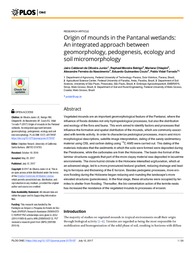Origin of mounds in the Pantanal wetlands: An integrated approach between geomorphology, pedogenesis, ecology and soil micromorphology.
Origin of mounds in the Pantanal wetlands: An integrated approach between geomorphology, pedogenesis, ecology and soil micromorphology.
Autoria: OLIVEIRA JUNIOR, J. C. de; BEIRIGO, R. M.; CHIAPINI, M.; NASCIMENTO, A. F. do; COUTO, E. G.; VIDAL-TORRADO, P.
Resumo: Vegetated mounds are an important geomorphological feature of the Pantanal, where the influence of floods dictates not only hydropedological processes, but also the distribution and ecology of the flora and fauna. This work aimed to identify factors and processes that influence the formation and spatial distribution of the mounds, which are commonly associated with termite activity. In order to characterize pedological processes, macro and micro morphological descriptions, satellite image interpretation, dating of the sandy sedimentary material using OSL and carbon dating using 14C AMS were carried out. This dating of the materials indicates that the sediments in which the soils were formed were deposited during the Pleistocene, while the carbonates are from the Holocene. The basin-like format of the laminar structures suggests that part of the more clayey material was deposited in lacustrine environments. The more humid climate in the Holocene intensified argilluviation, which at an advanced stage, led to a more pronounced textural gradient, reducing drainage and leading to ferrolysis and thickening of the E horizon. Besides pedogenic processes, more erosive flooding during the Holocene began reducing and rounding the landscape's more elevated structures (paleolevees). In the final stage, these structures were occupied by termites to shelter from flooding. Thereafter, the bio-cementation action of the termite nests has increased the resistance of the vegetated mounds to processes of erosion.
Ano de publicação: 2017
Tipo de publicação: Artigo de periódico
Unidade: Embrapa Agrossilvipastoril
Palavras-chave: Fauna, Flora, Mato Grosso, Plants, Wetland
Observações
1 - Por padrão são exibidas publicações dos últimos 20 anos. Para encontrar publicações mais antigas, configure o filtro ano de publicação, colocando o ano a partir do qual você deseja encontrar publicações. O filtro está na coluna da esquerda na busca acima.
2 - Para ler algumas publicações da Embrapa (apenas as que estão em formato ePub), é necessário ter, no celular ou computador, um desses softwares gratuitos. Sistemas Android: Google Play Livros; IOS: iBooks; Windows e Linux: software Calibre.
Acesse outras publicações
Acesse a Base de Dados da Pesquisa Agropecuária (BDPA) para consultar o acervo completo das bibliotecas da Embrapa.

